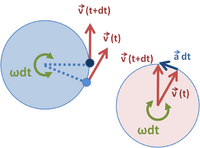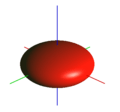Centrifugal force facts for kids
In physics, centrifugal force (from Latin centrum "center" and fugere "to flee") is a fictitious force that appears to act on all objects when viewed in a rotating frame of reference; it acts on anything with mass considered in such a frame. Centrifugal force is fictitious because although it may feel to a person like a certain force is being exerted on them, someone outside the scene will see something different.
Contents
Examples
Vehicle driving round a curve
A common experience that gives rise to the idea of a centrifugal force is encountered by passengers riding in a vehicle, such as a car, that is changing direction. If a car is traveling at a constant speed along a straight road, then a passenger inside is not accelerating and, according to Newton's second law of motion, the net force acting on them is therefore zero (all forces acting on them cancel each other out). If the car enters a curve that bends to the left, the passenger experiences an apparent force that seems to be pulling them towards the right. This is the fictitious centrifugal force. It is needed within the passengers' local frame of reference to explain their sudden tendency to start accelerating to the right relative to the car—a tendency which they must resist by applying a rightward force to the car (for instance, a frictional force against the seat) in order to remain in a fixed position inside. Since they push the seat toward the right, Newton's third law says that the seat pushes them towards the left. The centrifugal force must be included in the passenger's reference frame (in which the passenger remains at rest): it counteracts the leftward force applied to the passenger by the seat, and explains why this otherwise unbalanced force does not cause them to accelerate. However, it would be apparent to a stationary observer watching from an overpass above that the frictional force exerted on the passenger by the seat is not being balanced; it constitutes a net force to the left, causing the passenger to accelerate toward the inside of the curve, as they must in order to keep moving with the car rather than proceeding in a straight line as they otherwise would. Thus the "centrifugal force" they feel is the result of a "centrifugal tendency" caused by inertia. Similar effects are encountered in aeroplanes and roller coasters where the magnitude of the apparent force is often reported in "G's".
Stone on a string
If a stone is whirled round on a string, in a horizontal plane, the only real force acting on the stone in the horizontal plane is applied by the string (gravity acts vertically). There is a net force on the stone in the horizontal plane which acts toward the center.
In an inertial frame of reference, were it not for this net force acting on the stone, the stone would travel in a straight line, according to Newton's first law of motion. In order to keep the stone moving in a circular path, a centripetal force, in this case provided by the string, must be continuously applied to the stone. As soon as it is removed (for example if the string breaks) the stone moves in a straight line, as viewed from above. In this inertial frame, the concept of centrifugal force is not required as all motion can be properly described using only real forces and Newton's laws of motion.
In a frame of reference rotating with the stone around the same axis as the stone, the stone is stationary. However, the force applied by the string is still acting on the stone. If one were to apply Newton's laws in their usual (inertial frame) form, one would conclude that the stone should accelerate in the direction of the net applied force—towards the axis of rotation—which it does not do. The centrifugal force and other fictitious forces must be included along with the real forces in order to apply Newton's laws of motion in the rotating frame.
Earth
The Earth constitutes a rotating reference frame because it rotates once every 23 hours and 56 minutes around its axis. Because the rotation is slow, the fictitious forces it produces are often small, and in everyday situations can generally be neglected. Even in calculations requiring high precision, the centrifugal force is generally not explicitly included, but rather lumped in with the gravitational force: the strength and direction of the local "gravity" at any point on the Earth's surface is actually a combination of gravitational and centrifugal forces. However, the fictitious forces can be of arbitrary size. For example, in an Earth-bound reference system (where the earth is represented as stationary), the fictitious force (the net of Coriolis and centrifugal forces) is enormous and is responsible for the Sun orbiting around the Earth. This is due to the large mass and velocity of the Sun (relative to the Earth).
Weight of an object at the poles and on the equator
If an object is weighed with a simple spring balance at one of the Earth's poles, there are two forces acting on the object: the Earth's gravity, which acts in a downward direction, and the equal and opposite restoring force in the spring, acting upward. Since the object is stationary and not accelerating, there is no net force acting on the object and the force from the spring is equal in magnitude to the force of gravity on the object. In this case, the balance shows the value of the force of gravity on the object.
When the same object is weighed on the equator, the same two real forces act upon the object. However, the object is moving in a circular path as the Earth rotates and therefore experiencing a centripetal acceleration. When considered in an inertial frame (that is to say, one that is not rotating with the Earth), the non-zero acceleration means that force of gravity will not balance with the force from the spring. In order to have a net centripetal force, the magnitude of the restoring force of the spring must be less than the magnitude of force of gravity. This reduced restoring force in the spring is reflected on the scale as less weight — about 0.3% less at the equator than at the poles. In the Earth reference frame (in which the object being weighed is at rest), the object does not appear to be accelerating; however, the two real forces, gravity and the force from the spring, are the same magnitude and do not balance. The centrifugal force must be included to make the sum of the forces be zero to match the apparent lack of acceleration.
Note: In fact, the observed weight difference is more — about 0.53%. Earth's gravity is a bit stronger at the poles than at the equator, because the Earth is not a perfect sphere, so an object at the poles is slightly closer to the center of the Earth than one at the equator; this effect combines with the centrifugal force to produce the observed weight difference.
Applications
The operations of numerous common rotating mechanical systems are most easily conceptualized in terms of centrifugal force. For example:
- A centrifugal governor regulates the speed of an engine by using spinning masses that move radially, adjusting the throttle, as the engine changes speed. In the reference frame of the spinning masses, centrifugal force causes the radial movement.
- A centrifugal clutch is used in small engine-powered devices such as chain saws, go-karts and model helicopters. It allows the engine to start and idle without driving the device but automatically and smoothly engages the drive as the engine speed rises. Inertial drum brake ascenders used in rock climbing and the inertia reels used in many automobile seat belts operate on the same principle.
- Centrifugal forces can be used to generate artificial gravity, as in proposed designs for rotating space stations. The Mars Gravity Biosatellite would have studied the effects of Mars-level gravity on mice with gravity simulated in this way.
- Spin casting and centrifugal casting are production methods that use centrifugal force to disperse liquid metal or plastic throughout the negative space of a mold.
- Centrifuges are used in science and industry to separate substances. In the reference frame spinning with the centrifuge, the centrifugal force induces a hydrostatic pressure gradient in fluid-filled tubes oriented perpendicular to the axis of rotation, giving rise to large buoyant forces which push low-density particles inward. Elements or particles denser than the fluid move outward under the influence of the centrifugal force. This is effectively Archimedes' principle as generated by centrifugal force as opposed to being generated by gravity.
- Some amusement rides make use of centrifugal forces. For instance, a Gravitron's spin forces riders against a wall and allows riders to be elevated above the machine's floor in defiance of Earth's gravity.
Nevertheless, all of these systems can also be described without requiring the concept of centrifugal force, in terms of motions and forces in a stationary frame, at the cost of taking somewhat more care in the consideration of forces and motions within the system.
Images for kids
-
In the inertial frame of reference (upper part of the picture), the black ball moves in a straight line. However, the observer (brown dot) who is standing in the rotating/non-inertial frame of reference (lower part of the picture) sees the object as following a curved path due to the Coriolis and centrifugal forces present in this frame.
See also
 In Spanish: Fuerza centrífuga para niños
In Spanish: Fuerza centrífuga para niños






